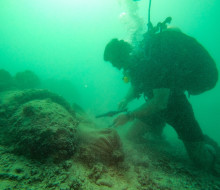
Second World War-era bombs in Vanuatu made safe by Navy divers
26 June 2024
Unfortunately you are viewing this website on an outdated browser which does not support the necessary features for us to provide an adequate experience. Please switch to a modern browser such as latest version of Google Chrome, Mozilla Firefox, Apple Safari or Microsoft Edge.
Ngā mihi nui
More than 300 New Zealand Army reservists and their Australian counterparts have taken part in the largest collective Reserve Force exercise in nearly 20 years.
Reserve Force soldiers traded their suits for boots as part of Exercise Tauwharenīkau, a simulated conflict exercise at Waiouru Military Training Area based on unrest on a fictional island in the South Pacific.
Over nine days it incorporated missions that were both intelligence-driven and action-based.
The lead unit for the exercise was Army Reserve Battalion, 3rd/6th Royal New Zealand Infantry Regiment (3/6 Battalion).
Commanding Officer, Lieutenant Colonel Nick Jones, said the exercise was intended to replicate the scale and complexity of operations soldiers were likely to encounter once deployed overseas.
“It improved our reservists’ ability to effectively work alongside each other as a collective, to integrate with the Regular Force and to enhance our interoperability with our Australian allies who also attended.”
Soldiers experienced operating within a combat team framework which was made up of a light infantry rifle company consisting of rifle platoons from both the New Zealand and Australian Army Reserve Forces, a command-and-control centre, an uncrewed aircraft system (UAS) detachment, communication and intelligence specialists, a mounted reconnaissance section, combat service support specialists, combat engineers and medics, including dental support.
“We trained with Royal New Zealand Air Force NH90 helicopters and NZ Light Armoured Vehicles (NZLAV) which deployed soldiers into remote and challenging environments, and also used a combat engineer dog handler and his Explosive Detection Dog, Flicker,” said Lieutenant Colonel Jones.
Exercise director Major Mike Beale from 3rd/6th Battalion said it was a valuable opportunity for Reserve Force soldiers to rub shoulders with different units.
“Reserves from other Army trades were integrated with the infantry company. Not only did they provide essential specialist skills, but this enhanced the combat capability of the company itself by creating what is known as a combined arms combat team.”
For many Army reserves, it was their first exposure to an NH90 and the NZLAV - which Private Tayla Craigen (2/4 Battalion) said was a highlight of the exercise. “I joined the Reserve Force to give back to my community, but also out of a sense of adventure and a love of being in the outdoors,” she said.
“Being in an NH90 was a new experience I will never forget and something I wouldn’t have been able to do as a civilian.”
Platoon Commander Second Lieutenant Angus Dysart-Paul (left) briefs his section commanders during a security task
Infantry soldiers and an NZLAV providing security during a combat mission to clear hostile forces from an area
Infantry soldiers advancing on a position held by hostile forces
Soldiers from 2nd Engineer Regiment and the Australian Defence Force, along with explosive detection dog ‘Flicker’, wait to board an NH90 before deploying into the field
Dental Officer Lieutenant Richard Sadipiralla examines the teeth of Major Ryan Clarke, Commanding Officer, Northland Company 3rd/6th Battalion
Lieutenant Colonel Jones said the exercise was supported by a team of experienced officers and soldiers, and showed that the Army’s Reserve Force was combat ready.
“The training had an edge to it - it needs to because our people need to be prepared. We need to be prepared to fight alongside each other, our Regular Force, and our Australian ally – that’s what I mean by being combat ready.”
The amount of planning that goes in to these types of exercises is significant, especially when combining forces with the Australian Reserve Force.
Major John Dunn, Australian Army Contingent Commander, said 38 Australian reservists took part in Exercise Tauwharenīkau.
“Enabling our Australian reservists the opportunity to take part is vital to building and strengthening the Australia-New Zealand relationship that we’ve nurtured for over 100 years.
“We have our similarities in the way we work, but also our differences. That’s why this exercise is important - so we can adapt to each other and work efficiently together.”
The New Zealand Army currently consists of around 4,600 Regular Force, and just over 2,100 Reserve Force soldiers.